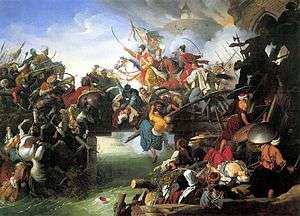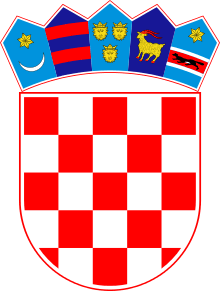Military history of Croatia
The military history of Croatia encompasses wars, battles and all military actions fought on the territory of modern Croatia and the military history of the Croat people regardless of political geography.
Medieval Croatian states
Croatian principalities
The first mention of Croatian military actions dates from the time of the Croatian principalities in the 8th and 9th centuries. Vojnomir of Pannonian Croatia led a Croatian army in wars against the Avars at the end of the 8th century. He launched a joint counterattack with the help of Frankish troops under Charlemagne in 791. The offensive was successful and the Avars were driven out of what then became Pannonian Croatia under Frankish overlords. In 819, his successor Duke Ljudevit Posavski raised a rebellion against the Franks. Ljudevit won many battles against the Franks, but in 822 his forces were defeated. Prince Borna of Croatia led the army of Dalmatian Croatia and had a primary role in crushing Ljudevit's rebellion. Borna reported his successes to the Frankish Emperor, stating that Ljudevit had lost over 3,000 soldiers and 300 horses during his campaign. Prince Trpimir I of Croatia battled successfully against his neighbours, the Byzantine coastal cities under the strategos of Zadar in 846–848. In 853 he repulsed an attack from an Army of the Bulgarian Khan Boris I and concluded a peace treaty with him, exchanging gifts. Prince Domagoj of Croatia is known in the history for his navy which helped the Franks to conquer Bari from the Arabs in 871. During Domagoj's reign piracy was a common practice, which earned him a title of The worst duke of Slavs (Latin: pessimus dux Sclavorum). One of the strongest Croatian princes was Branimir, whose naval fleet defeated the Venetian navy on 18 September 887.
Kingdom of Croatia
First Croatian king Tomislav defeated the Magyar mounted invasions of the Arpads in battle and forced them across the Drava River. In 927 Tomislav's army heavily defeated the army of Bulgarian Emperor Simeon, under the command of general Alogobotur in the Battle of the Bosnian Highlands. One of Tomislav's admirals lead more than 5,000 sailors, soldiers and their families into Slavic quarter of Palermo, Sicily. At the peak of his reign, according to Byzantine emperor Constantine VII Porphyrogenitos' De Administrando Imperio, written around 950, Tomislav could raise a vast military force composed out of 100,000 infantrymen and 60,000 horsemen and a sizable fleet of 80 large ships and 100 smaller vessels. According to the palaeographic analysis of the original manuscript of De Administrando Imperio, the estimation of the number of inhabitants in medieval Croatia between 440 and 880 thousand people, and military numbers of Franks and Byzantines - the Croatian military force was most probably composed of 20,000-100,000 infantrymen, and 3,000-24,000 horsemen organized in 60 allagions.[1][2]
King Dmitar Zvonimir of Croatia took the hard line against the Byzantine Empire and joined the Normansin wars against Byzantium. When Robert Guiscard, Duke of Apulia, invaded the western Balkan provinces of the empire in 1084, Zvonimir sent troops to his aid.
King Petar Svačić's troops maintained resistance against repelling Hungarian assaults at Mount Gvozd in the war for the succession of the Croatian throne. At the end, the last native Croatian king was defeated and killed by King Coloman of Hungary in the Battle of Gvozd Mountain (1097).
Notable wars and battles of early medieval times
Notable wars and battles that included Croatian army:
- Siege of Trsat (799)
- Battle of Kupa (819)
- Battle of Drava River (925)
- Croatian-Bulgarian wars
- Battle of the Bosnian Highlands (926)

- Battle of Gvozd Mountain (1097)
- Siege of Zadar (1202) – part of Fourth Crusade
- Fifth Crusade (1213–1221)
- Battle of Klis Fortress (1242) – part of Mongol invasion of Europe
- Battle of Grobnik field (1242)
- Battle of Bliska (1322)
- Battle of Samobor (1441)
Ottoman Conquest (15th–18th centuries)
- Hundred Years' Croatian–Ottoman War:
- Battle of Krbava field (1493)
- Battle of Dubica (1513)
- Siege of Klis (1524)
- Siege of Jajce (1524)
- Battle of Mohács (1526)
- Hungarian campaign of 1527–1528
- Balkan campaign of 1529
- Little War in Hungary (1530 – c.1552)
- Siege of Güns (1532)
- Battle of Đakovo (1537)
- Battle of Szigetvár (1566)
- Siege of Gvozdansko (1577–1578)
- Battle of Brest (1592)

- Battle of Sisak (1593)
- Long War (1593–1606)
- Great Turkish War (1662–1699)
- Austro-Turkish War (1663–1664)
- Battle of Saint Gotthard (1664)
- Battle of Mohács (1687)
- Battle of Slankamen (1691)
- Battle of Zenta (1697)
- Battle of Petrovaradin (1716)
- Battle of Saint Gotthard (1705)
Historic units and formations originating from the time of the Ottoman wars:
- Military Frontier
- Grenz infantry
- Uskoci
- Pandurs
- Royal Cravattes
- Royal Croatian Home Guard
19th century
At the beginning of the 19th century many Croatian troops (as a part of the Austrian imperial army) fought in the Napoleonic wars against the French Grande Armée. Later, a significant Croatian force (four regiments) fought on the French side during Napoleon's invasion of Russia.[3]

At the end of the first half of the 19th century, following in the wake of the French revolution, Croatian romantic nationalism emerged to counteract the non-violent but apparent Germanization and Magyarization. By the 1840s, and during the revolutions of 1848, the movement had moved from cultural goals to resisting Hungarian political demands which grew even bigger during the Hungarian Revolution of 1848. Croatian Ban Josip Jelačić cooperated with the Austrians in quenching the Hungarian Revolution of 1848 by leading a military campaign into Hungary.
- Battles of the Hungarian Revolution involving Croats:
- Battle of Pákozd (1848)
- Vienna Uprising (1848)
- Battle of Schwechat (1848)
- Battle of Mór (1848)
Croatian troops also contributed in other conflicts which involved the Austrian Empire. According to the sources, out of 7,871 sailors on Austrian ships around 5,000 were Croats.[4] Many Croatian sailors fought on the Austrian side in 1866 during Third Italian War of Independence in the Battle of Vis.
20th century
World War I

During World war I, Croatian soldiers served in Croatian Home Guard units, Croatian military section of Austro-Hungarian army formed after Croatian–Hungarian Agreement of 1868. Most notable Croatian commanders of that time were Field Marshal Svetozar Boroević, General Stjepan Sarkotić and Admiral Maximilian Njegovan.
Notable battles of World War I that included Croatian troops:
- Serbian Campaign (World War I) (1914)
- Adriatic Campaign of World War I (1914–1918)
- Battle of Galicia (1914)
- Brusilov Offensive (1916)
- Battle of Soča (1915)
- Battle of Caporetto (1917)
- Bombardment of Ancona (1915)
- Battle of the Piave River (1918)
- Battle of Vittorio Veneto (1918)
The end of World War I was followed by the dissolution of the Austro-Hungarian monarchy and the formation of new national states. The State of Slovenes, Croats and Serbs was formed from the southernmost parts of the Austria-Hungary but it lasted for only a month. After it was clear that Austria-Hungary had lost World War I, the Austrian government decided to give much of the Austro-Hungarian Navy fleet, to the newly formed State of Slovenes, Croats and Serbs. This move would have avoided handing the fleet to the Allies, since the new state had declared neutrality. Soon, the Fleet was attacked and dismembered by the Italian Regia Marina and the flagship SMS Viribus Unitis was sunk along with his captain and commander of Navy of the newly formed state, admiral Janko Vuković.
World War II

Battles of World War II:
- Invasion of Yugoslavia (1941)
- Battle of Stalingrad (1942)
- Battle of Neretva (1943)
- Battle of Sutjeska (1943)
- Battle on Lijevča field (1945)
- Battle of Sarajevo (1945)
- Battle of Odžak (1945)
Croatian War of Independence
Battles of Croatian War of Independence:
- Operation Coast-91 (1991)
- Battle of the Dalmatian channels (1991)
- Battle of Vukovar (1991)
- Battle of the barracks (1991)
- Operation Otkos 10 (1991)
- Siege of Dubrovnik (1991)
- Operation Maslenica (1993)
- Operation Medak pocket (1993)
- Operation Flash (1995)
- Operation Storm (1995)
- Bosnian War
- Croat–Bosniak War (1992–1994)
- Operation Winter '94 (1994)
- Operation Summer '95 (1995)
- Operation Mistral 2 (1995)
- Operation Southern Move (1995)
See also
- History of Croatia
- History of Croatian Navy
- History of Croatian Air Force
- Military of Croatia
- List of Croatian soldiers
References
- Vedriš, Trpimir (2007). "Povodom novog tumačenja vijesti Konstantina VII. Porfirogeneta o snazi hrvatske vojske" [On the occasion of the new interpretation of Constantine VII Porphyrogenitus'report concerning the strength of the Croatian army]. Historijski zbornik (in Croatian). 60: 1–33. Retrieved 29 July 2020.
- Budak, Neven (2018). Hrvatska povijest od 550. do 1100 [Croatian history from 550 until 1100]. Leykam international. pp. 223–224. ISBN 978-953-340-061-7.
- Napoleon's Foreign Infantry
- The Battle of Vis, by Ante Sucur
- Enciklopedija leksikografskog zavoda 1966–69 (in Croatian)


